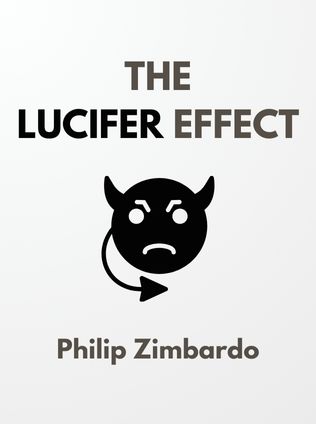
The Lucifer Effect
Understanding How Good People Turn Evil
By Philip Zimbardo
Published 04/2007
About the Author
Philip Zimbardo, born on March 23, 1933, in New York City, is a celebrated American psychologist and professor emeritus at Stanford University. Zimbardo's career has been marked by his extensive research in the field of social psychology, particularly focusing on the complexities of human behavior under various social influences. He is most famously known for the Stanford Prison Experiment conducted in 1971, which catapulted him into the limelight and established him as a leading authority on the study of situational power and its impact on morality.
Zimbardo's work extends beyond academic research; he has been an active public speaker, author, and advocate for social change. His contributions to psychology have been recognized worldwide, earning him numerous accolades and awards. Zimbardo's ability to translate complex psychological concepts into accessible language has made him a popular figure not only in academic circles but also among the general public. His book, The Lucifer Effect, is a culmination of his decades of research, offering profound insights into the darker aspects of human nature and the conditions that can lead ordinary people to commit extraordinary acts of evil.
Main Idea
The core thesis of The Lucifer Effect revolves around the idea that evil is not an inherent trait within individuals but rather a result of external circumstances and social pressures. Zimbardo argues that under certain conditions, any person can be influenced to commit acts that are considered immoral or evil. He challenges the traditional view that only a few "bad apples" are responsible for heinous acts, proposing instead that situational forces and systemic structures play a significant role in shaping human behavior.
This concept is deeply rooted in Zimbardo's own experiences and observations during the Stanford Prison Experiment, where he witnessed firsthand how quickly and dramatically people could be transformed by their environment. He posits that understanding the situational and systemic factors that lead to evil is crucial for preventing such behavior in the future. Zimbardo's exploration of these ideas is not merely academic; it is a call to action, urging readers to recognize the power of context in shaping behavior and to take steps to create environments that foster goodness rather than corruption.
Table of Contents
- The Nature of Human Evil
- The Stanford Prison Experiment
- Circumstantial Variables That Can Corrupt Morality
- The Role of Social Pressures
- The Impact of Anonymity and Dehumanization
- Powerful Institutions and Their Influence
- Resisting the Influence of Evil
The Nature of Human Evil
Zimbardo begins his exploration by addressing the fundamental question of what constitutes evil. He defines evil as "the exercise of power to intentionally harm (psychologically), hurt (physically), or destroy (mortally) and commit crimes against humanity" (Zimbardo). This broad definition encapsulates various forms of malevolent behavior, from everyday acts of cruelty to large-scale atrocities like genocide.
To delve deeper into the origins of evil, Zimbardo presents two competing theories: the theory of fixed morals and the theory of circumstantial morals. The former suggests that some people are innately good or evil, and their actions reflect their fixed moral character. This perspective is comforting because it allows society to categorize individuals into clear moral categories—heroes and villains, saints and sinners. However, Zimbardo challenges this notion, advocating instead for the theory of circumstantial morals, which posits that human behavior is highly malleable and influenced by external circumstances.
This theory is supported by numerous psychological studies, including Zimbardo's own Stanford Prison Experiment, which demonstrated how quickly individuals could be corrupted by their environment. Zimbardo argues that "any one of us could commit the worst evil imaginable if we found ourselves in the wrong situation" (Zimbardo). This assertion is unsettling because it blurs the line between good and evil, suggesting that under certain conditions, anyone is capable of perpetrating acts of cruelty.
Zimbardo also introduces the concept of the Knobe effect, which highlights a cognitive bias in how we perceive morality. The Knobe effect suggests that when people observe someone committing a harmful act, they are more likely to attribute it to the person's character rather than external factors. Conversely, when observing a good deed, people are more likely to believe that it was motivated by the situation rather than the individual's inherent goodness. This bias reinforces the theory of fixed morals and obscures the influence of situational factors on behavior.
The Stanford Prison Experiment
The Stanford Prison Experiment (SPE) is a cornerstone of Zimbardo's argument and serves as a powerful case study in the exploration of human evil. Conducted in August 1971, the experiment involved 24 male college students who were randomly assigned the roles of guards and prisoners in a simulated prison environment. The experiment was initially planned to last two weeks, but it was terminated after just six days due to the extreme and disturbing behavior exhibited by the participants.
Sign up for FREE and get access to 1,400+ books summaries.
You May Also Like
The Subtle Art of Not Giving a F*ck
A Counterintuitive Approach to Living a Good Life
By Mark MansonRich Dad Poor Dad
What the Rich Teach Their Kids About Money - That the Poor and Middle Class Do Not!
By Robert T. KiyosakiHow To Win Friends and Influence People
The All-Time Classic Manual Of People Skills
By Dale CarnegieFreakonomics
A Rogue Economist Explores the Hidden Side of Everything
By Steven D. Levitt and Stephen J. Dubner



















